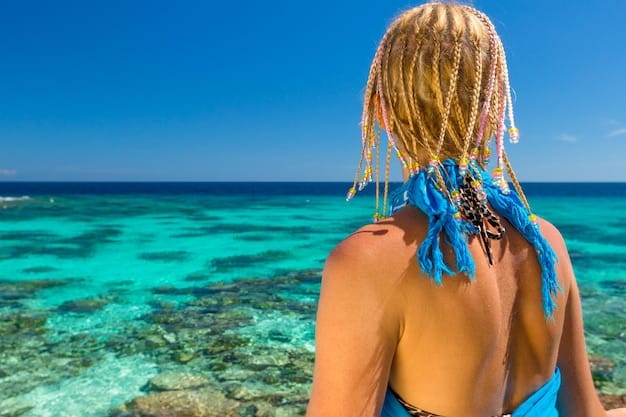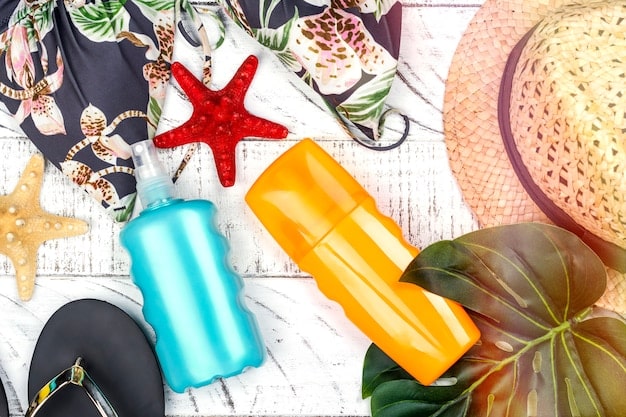Beach-Friendly Hairstyles: Protect Your Hair at the Beach

Beach-friendly hairstyles are essential for protecting hair from sun, salt, and wind damage while ensuring a stylish and comfortable experience during your coastal getaways.
Heading to the beach is a wonderful experience, but the combination of sun, salt, and wind can be incredibly harsh on your hair. Understanding how to protect your strands while still looking fabulous is key. This comprehensive guide delves into the best beach-friendly hairstyles: protecting your hair from sun, salt, and wind, ensuring your hair remains healthy, hydrated, and beautiful, even after a day under the sun.
Understanding the Elements: Sun, Salt, and Wind Damage
Spending a day at the beach offers unparalleled relaxation and enjoyment, but it also exposes your hair to a trio of natural elements that can cause significant damage. Recognizing how sun, salt, and wind individually and collectively impact your hair is the first step toward effective protection and maintaining its health.
The sun, much like on your skin, can cause oxidative damage to your hair. UV radiation breaks down the protein structure of your hair, leading to weakened strands, diminished elasticity, and faded color. Prolonged exposure can make hair brittle, dry, and prone to breakage, transforming
lustrous locks into dull, lackluster tresses.
The Impact of Saltwater on Your Hair
Saltwater, while refreshing for a dip, acts as a desiccant, drawing moisture out of your hair. The sodium chloride crystals left behind on your hair after swimming absorb water from the hair shaft, leaving it parched and rough. This dehydration can lead to frizz, tangles, and a brittle texture, making your hair more susceptible to damage from styling and environmental factors.
- Dehydration: Salt extracts moisture, leading to dryness.
- Rough Texture: Hair cuticles can lift, making strands feel coarse.
- Increased Breakage: Dry, rough hair is more prone to snapping.
Wind, often a welcome breeze on a hot beach day, can paradoxically be detrimental to your hair. Constant whipping and tangling can lead to physical damage, knots, and breakage. The wind can also cause friction between individual strands, stripping away the hair’s natural oils and exacerbating dryness caused by the sun and salt. This combination can result in a challenging “beach hair” look that is less chic and more chaotic.
Together, these elements create a perfect storm for hair damage. UV rays weaken the hair shaft, saltwater dehydrates it, and wind tangles and abrades it, leaving your hair vulnerable. Understanding these impacts highlights the importance of proactive measures and choosing appropriate hairstyles to minimize exposure and maximize protection. This knowledge forms the foundation for selecting the best beach-friendly hairstyles that not only look great but also safeguard your hair’s health.
Pre-Beach Hair Preparation: Your First Line of Defense
Before you even step onto the sand, preparing your hair can significantly minimize the damage caused by the sun, salt, and wind. This proactive approach acts as a crucial shield, creating a barrier that locks in moisture and protects the hair’s structural integrity. Neglecting these steps can leave your hair vulnerable, quickly leading to dryness, frizz, and breakage.
One of the most effective pre-beach treatments is applying a protective layer to your hair. This can be a leave-in conditioner, a hair oil, or a specialized beach spray designed to counteract environmental damage. Look for products that contain UV filters, which act much like sunscreen for your hair, shielding it from harmful ultraviolet rays. Ingredients like argan oil, coconut oil, or shea butter can provide a nourishing barrier, preventing saltwater from dehydrating your strands.
Hydration and Nourishment
Ensuring your hair is well-hydrated before exposure is paramount. Dry hair is more porous and absorbs more salt, leading to greater damage. A deep conditioning treatment a day or two before your beach trip can significantly improve your hair’s resilience. This replenishes moisture and strengthens the hair shaft, making it less susceptible to the drying effects of saltwater and sun. Avoid harsh shampoos or products right before your beach day that might strip your hair of its natural oils.
- Leave-in conditioner: Creates a protective layer.
- Hair oils (argan, coconut): Provide moisture and a barrier.
- UV protection sprays: Shields from sun damage.
Consider rinsing your hair with fresh water before jumping into the ocean or pool. Wet hair is less likely to absorb large amounts of chlorinated or saltwater, as the hair shaft will already be saturated with clean water. This simple step can dramatically reduce the amount of salt and chemicals your hair takes in, preventing them from penetrating deeply and causing damage. This also helps seal the hair cuticle, making it less receptive to dehydration.
Pre-beach hair preparation is not just about applying products; it’s about building a robust defense system for your strands. By hydrating your hair, applying protective barriers, and rinsing with fresh water, you set the stage for a day of worry-free enjoyment, knowing your hair is well-equipped to withstand the rigors of the beach environment. This foundational step is essential for maintaining healthy, beautiful hair throughout your beach getaway.
Top Beach-Friendly Hairstyles: Practicality Meets Style
When it comes to beach-friendly hairstyles, the goal is to combine practicality with effortless style. The best options not only look great but also provide maximum protection against the elements, minimizing tangles, reducing exposure, and keeping your hair securely in place. Moving beyond loose, flowing hair the moment you hit the sand is key to avoiding an unruly mess by lunchtime.
Braids are arguably the most versatile and protective beach hairstyles. A simple three-strand braid, a chic French braid, or intricate Dutch braids can keep your hair securely tucked away, preventing it from tangling in the wind and significantly reducing its surface area exposed to the sun and saltwater. Braids also look stylish and unravel into beautiful, natural-looking waves once you take them out, making them ideal for transitioning from beach to evening activities.
Chic Updos and Buns
High buns and top knots are excellent choices for keeping hair entirely off your neck and face, providing optimal comfort on a hot day. A messy bun, while seemingly casual, can be surprisingly effective at protecting your hair if secured properly. For added protection, consider twisting your hair into a bun at the nape of your neck, allowing it to remain relatively sheltered under a hat. These styles help to minimize direct sun exposure and prevent your hair from getting soaked and tangled in the water.
- Braids: French, Dutch, or simple braids for secure, tangle-free hair.
- Buns: High buns or messy buns to keep hair off the face and neck.
- Ponytails: Low or high ponytails for quick, easy styling.
While ponytails are a classic, quick option, opting for a low ponytail can offer more protection than a high one, as it keeps more of your hair shielded by your back. Ensure you use a soft hair tie or scrunchie to prevent breakage and avoid pulling your hair too tightly, which can lead to tension headaches. For added flair and protection, consider incorporating accessories like scarves or bandanas into these styles. Not only do they add a stylish touch, but they also provide an extra layer of defense against UV rays and physical damage from wind.

Ultimately, the best beach-friendly hairstyle is one that you find comfortable, secure, and stylish. Experiment with different braids, buns, and ponytails, and don’t hesitate to integrate protective accessories. The key is to keep your hair contained and minimize its exposure to the harsh beach elements, ensuring your locks remain healthy and beautiful throughout your coastal adventures. These styles prove that practicality and fashionable looks can go hand-in-hand, even at the beach.
Styling with Accessories: Hats and Scarves
Beyond simply taming your hair, incorporating accessories like hats and scarves into your beach look offers a dual benefit: they elevate your style while providing an invaluable layer of protection against the harsh elements. These aren’t just fashion statements; they are essential tools in your arsenal for safeguarding your hair and scalp from sun, salt, and wind damage.
Hats are arguably the most effective accessory for beach hair protection. A wide-brimmed hat is ideal, as it not only shades your hair but also your face, ears, and neck from direct UV radiation. Straw hats are classic beach wear, offering good ventilation, but ensure the weave is tight enough to block out sufficient sunlight. Baseball caps can also offer some protection, especially for the scalp and hairline, but less so for the lengths of your hair. Choosing a hat made from UV-protective fabric provides the highest level of defense.
The Versatility of Scarves and Bandanas
Scarves and bandanas are incredibly versatile and stylish options for protecting your hair at the beach. They can be tied in countless ways – as a head wrap, a turban, or woven into a braid or ponytail. When worn as a full head wrap, a scarf provides comprehensive coverage, shielding your entire scalp and hair from the sun’s rays and preventing wind from tangling your locks.
- Wide-brimmed hats: Offer extensive sun protection for hair and skin.
- UV-protective fabrics: Provide superior defense against harmful rays.
- Scarves and bandanas: Versatile for head wraps, turbans, or woven styles.
Opt for scarves made from lightweight, breathable materials like cotton, linen, or silk to ensure comfort and prevent your head from overheating. Darker colors tend to absorb more UV radiation, offering slightly better protection than lighter shades. The added benefit of scarves is their ability to hold your hairstyle in place, making them perfect for keeping braids or buns secure while you enjoy your beach activities. They also add a pop of color or pattern to your beach ensemble, enhancing your overall look.
Using hats and scarves is a simple yet highly effective way to enhance your beach-friendly hair routine. They offer a tangible barrier against damaging environmental factors, ensuring that your hair remains healthy and beautiful. By thoughtfully choosing and styling these accessories, you can enjoy a day at the beach with peace of mind, knowing your hair is well-protected and looking fabulous. These accessories transform your beach look from merely functional to fashionable and fully prepared.
After-Beach Hair Care: Rejuvenation and Repair
The moment you step off the sand, your hair begins its recovery process from the day’s environmental assault. After-beach hair care is just as crucial as pre-beach preparation, serving to cleanse, rehydrate, and repair strands that have been exposed to sun, salt, and wind. Neglecting this vital step can lead to cumulative damage, diminishing your hair’s vitality over time.
The first step in your after-beach routine should always be to thoroughly rinse your hair with fresh, cool water. This helps to wash away any lingering saltwater, sand, and sweat that can dry out and irritate your scalp and hair. Using cool water also helps to seal the hair cuticles, locking in moisture and making your hair appear smoother and shinier. Avoid hot water, which can further strip the hair of its natural oils.
Cleansing and Deep Conditioning
Following a good rinse, use a gentle, moisturizing shampoo to cleanse your hair. Look for products that are sulfate-free and designed for hydration or repair. A clarifying shampoo might be beneficial a few times a month to remove mineral buildup, but for daily use after the beach, focus on nourishing formulas. Immediately follow with a rich, deep conditioning treatment or a hair mask. This is where you replenish the lost moisture and nutrients, helping to repair the hair shaft and restore elasticity.
- Rinse with cool water: Removes salt and sand, seals cuticles.
- Use gentle, sulfate-free shampoo: Cleanses without stripping oils.
- Apply deep conditioner/hair mask: Rehydrates and repairs damage.
Limit heat styling as much as possible after a beach day. Your hair is already vulnerable and stressed from sun and salt exposure, and adding more heat can exacerbate dryness and breakage. If you must use heat, apply a heat protectant spray generously. Instead, opt for air drying or gentle towel-drying, and allow your hair to recover naturally. Consider applying a leave-in treatment or a few drops of hair oil (like argan or jojoba oil) to the ends of your hair while it’s still damp to add an extra layer of moisture and shine.
An evening routine focused on hydration and repair can make a significant difference. Regular trims can also help remove split ends caused by environmental exposure, keeping your hair looking healthier in the long run. By consistently dedicating time to after-beach care, you ensure that your hair not only recovers from its adventures but also stays resilient and vibrant, ready for your next beach escapade. This holistic approach ensures long-term hair health and beauty.
Must-Have Hair Products for Your Beach Bag
Curating the perfect beach bag isn’t just about packing a towel and sunscreen; it’s also about equipping yourself with the right hair products to combat the elements. Having these essentials on hand ensures that you can protect, refresh, and maintain your hair’s health throughout your beach day and beyond. Selecting multi-functional products can also save space and weight in your bag, making your beach excursion smoother and more enjoyable.
A high-quality leave-in conditioner with UV protection is non-negotiable. This product acts as a protective shield, hydrating your hair and creating a barrier against sun and saltwater damage. Look for formulas that are lightweight and won’t make your hair feel greasy, even when applied repeatedly. Many of these products come in spray form, making them easy to apply evenly and quickly, even on the go. Some are specifically designed to be water-resistant, offering long-lasting protection.
Essential Tools and Hydrating Sprays
Alongside your leave-in, a wide-tooth comb is essential for detangling wet hair. When hair is wet, it’s most fragile and prone to breakage, so a wide-tooth comb minimizes pulling and prevents further damage. Avoid brushes with fine bristles, which can snag and break strands. A hydrating hair mist or a conditioning spray can be a game-changer for touch-ups throughout the day. These products can refresh your hair, add moisture, and help tame frizz caused by humidity and wind without requiring a full rinse.
- Leave-in conditioner with UV protection: Essential shield against sun and salt.
- Wide-tooth comb: Gentle detangling for wet, fragile hair.
- Hydrating hair mist: Refreshes and moisturizes on the go.

Don’t forget a soft scrunchie or hair ties. These are crucial for securing your protective hairstyles without causing creases or damage. Avoid elastics with metal parts, which can snag and break hair strands. Finally, a small bottle of clarifying shampoo and a travel-sized deep conditioning mask for your after-beach routine are smart additions. You might not use them on the beach, but having them ready for your post-beach shower ensures you can properly cleanse and rejuvenate your hair, washing away any residual salt and sand and replenishing lost moisture.
Stocking your beach bag with these must-have hair products transforms your beach experience. You’ll be prepared to face the elements head-on, ensuring your hair remains healthy, manageable, and beautiful. These essentials prove that a little preparation and the right tools can make all the difference in safeguarding your hair against the rigors of a beach day, allowing you to fully enjoy your time by the water.
Long-Term Hair Health: Beyond the Beach Day
Maintaining optimal hair health extends far beyond the immediate beach day. The cumulative effects of environmental exposure, even with diligent care, necessitate a broader, long-term strategy to ensure your hair remains vibrant and resilient. Adopting consistent habits and integrating specific treatments can counteract future damage and sustain the benefits of your beach-friendly hair routine.
Regular deep conditioning treatments are fundamental. Whether once a week or bi-weekly, incorporating a nourishing hair mask into your routine helps to replenish moisture, repair damage, and strengthen the hair shaft. Look for masks rich in proteins, ceramides, and natural oils, which can penetrate deeply and restore your hair’s protective barrier. This consistent hydration acts as a preventative measure against dryness and brittleness, keeping your hair supple and less prone to breakage.
Diet and Lifestyle for Healthy Hair
What you consume significantly impacts your hair’s health. A balanced diet rich in vitamins, minerals, and proteins is essential for strong, healthy hair growth. Include foods high in Omega-3 fatty acids (like salmon and avocados), Vitamin E (nuts and seeds), biotin (eggs, sweet potatoes), and iron (lean meats, spinach). Staying adequately hydrated by drinking plenty of water also contributes to overall hair moisture and elasticity, making it more resilient to external stressors.
- Regular deep conditioning: Restores moisture and strengthens hair.
- Balanced diet: Provides nutrients for healthy growth.
- Limit heat styling: Reduces damage and preserves hair integrity.
Minimizing heat styling and chemical processing is crucial for long-term hair health. Frequent use of flat irons, curling irons, and blow dryers, especially without proper heat protectants, can strip hair of its natural moisture and weaken its structure over time. Similarly, excessive coloring, perms, or relaxers can cause significant damage. Allowing your hair to air dry more often and embracing its natural texture can give it a much-needed break and promote overall health.
Regular trims are also vital. While they don’t make your hair grow faster, they remove split ends and damaged sections, preventing them from traveling further up the hair shaft. This keeps your hair looking neater, feeling softer, and being generally healthier. Developing a consistent hair care routine tailored to your hair type and concerns, and adjusting it seasonally, ensures that your hair consistently receives the attention and protection it needs to thrive, regardless of environmental challenges. This holistic approach ensures that your hair remains a crowning glory, ready for any adventure.
Common Hair Mistakes to Avoid at the Beach
Even with the best intentions, certain common mistakes can inadvertently damage your hair during a beach outing. Avoiding these pitfalls is as crucial as practicing good protection and care. Being mindful of these errors can significantly contribute to maintaining your hair’s health and appearance, ensuring your beach experience is truly carefree and enjoyable.
One of the most frequent mistakes is underestimating the sun’s power. Many people protect their skin but forget about their hair and scalp. Leaving your hair completely exposed to direct sunlight for extended periods without any form of UV protection (like a hat, scarf, or SPF hair product) can lead to severe dryness, color fading, and protein degradation. This oversight can quickly unravel all your pre-beach preparation efforts.
Aggressive Detangling and Lack of Rinsing
Another common misstep is aggressive detangling of wet, salty hair. Hair is weakest when wet, and the combination of water and salt can make it especially prone to tangles. Forcing a comb or brush through knotted hair can cause significant breakage and damage to the hair shaft. Instead, always use a wide-tooth comb and work from the ends upwards, gently teasing out knots. Applying a leave-in conditioner before detangling can also provide extra slip and make the process smoother.
- Underestimating sun exposure: Neglecting UV protection for hair.
- Aggressive detangling: Brushing wet, tangled hair harshly.
- Not rinsing hair post-swim: Leaving salt and chlorine to dry.
Failing to rinse your hair immediately after swimming in saltwater or chlorine is a major oversight. Allowing salt crystals or chlorine residue to dry on your hair can severely dehydrate it and cause significant damage. These chemicals continue to draw moisture from the hair and can lead to brittleness and color alteration. A quick rinse with fresh water, even if it’s just from a beach shower, can make a world of difference in preventing this cumulative damage.
Finally, neglecting post-beach deep conditioning treatments can lead to prolonged dryness and dullness. It’s easy to feel tired after a day at the beach and skip this crucial step, but your hair needs that deep hydration and repair to bounce back. Consistently rehydrating with deep conditioners or masks after every beach visit is vital for reversing the immediate effects of sun and salt. By consciously avoiding these common mistakes, you ensure your hair stays healthy and beautiful, ready for countless more beach adventures without compromise.
| Key Point | Brief Description |
|---|---|
| ☀️ Hair Protection Heroes | Hats, scarves, and UV-protective sprays are essential for blocking sun and wind damage. |
| 💧 Hydration is Key | Pre-beach leave-ins and post-beach deep conditioners combat dryness from salt and sun. |
| 🥨 Protective Styles | Braids, buns, and low ponytails minimize tangles and exposure to harsh elements. |
| 🚿 Rinse & Recover | Immediate rinsing after swimming and gentle detangling prevents significant post-beach damage. |
FAQs: Your Beach Hair Questions Answered
▼
Braids (French, Dutch, or simple), high buns, and low ponytails are excellent for preventing tangles. These styles keep hair contained, reducing exposure to wind and minimizing friction between strands. Securing them with soft hair ties further prevents knots and breakage, ensuring your hair stays smooth and manageable throughout the day, even after swimming in salty water.
▼
Saltwater dehydrates hair by drawing out moisture, leading to dryness, frizz, and brittleness. To prevent this, apply a leave-in conditioner or hair oil before swimming to create a protective barrier. Rinsing your hair with fresh water before and immediately after swimming also helps by saturating the hair shaft, making it less absorbent to salt, thus minimizing damage.
▼
Absolutely. Hats, especially wide-brimmed ones, and scarves provide a physical barrier against harmful UV rays and strong winds, protecting both your hair and scalp. They prevent sun-induced damage, color fading, and tangling. Opt for UV-protective fabrics or tightly woven materials for maximum effectiveness, and choose breathable options for comfort in the heat.
▼
Your beach bag should include a leave-in conditioner with UV protection, a wide-tooth comb for gentle detangling, and soft hair ties or scrunchies. A hydrating hair mist can also be useful for refreshing your hair throughout the day. These products are crucial for offering immediate protection and maintaining your hair’s health while at the beach.
▼
After-beach hair care is vital for repairing and rejuvenating your hair. It should always start with thoroughly rinsing your hair with fresh, cool water to remove salt and sand. Follow with a gentle, moisturizing shampoo and a deep conditioning treatment or hair mask to replenish lost moisture and nutrients. Avoid excessive heat styling post-beach to allow your hair to recover naturally.
Conclusion
Navigating a day at the beach doesn’t have to mean sacrificing your hair’s health or style. By understanding the damaging effects of sun, salt, and wind, and by proactively implementing protective measures, you can ensure your locks remain vibrant and beautiful. From targeted pre-beach preparations and strategic protective hairstyles to essential after-beach care and the intelligent use of accessories, every step plays a crucial role. Embrace these beach-friendly strategies, and enjoy your coastal adventures knowing your hair is well-equipped to withstand the elements, looking fabulous and feeling healthier than ever.





